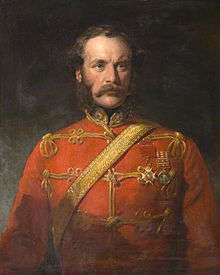Edward Greathed
| Sir Edward Greathed | |
|---|---|
 Sir Edward Greathed | |
| Born |
8 June 1812 London |
| Died | 19 November 1881 (aged 69) |
| Allegiance |
|
| Service/branch |
|
| Rank | General |
| Commands held |
8th (The King's) Regiment of Foot Eastern District |
| Battles/wars | Indian Rebellion |
| Awards | Knight Commander of the Order of the Bath |
General Sir Edward Harris Greathed KCB (8 June 1812 – 19 November 1881) was a British Army officer who became General Officer Commanding Eastern District.
He was born in London to Edward Harris and Mary Elizabeth Glyn and baptised in Chalbury, Dorset. He was educated at Westminster School before being commissioned as an ensign in the 8th (The King's) Regiment of Foot on 22 June 1832.[1]
He rose through the ranks to became commanding officer of the 8th (The King's) Regiment of Foot and, in that capacity, commanded the a column which defeated and dispersed some 5,000 rebels at the Battle of Agra in August 1857 during the Indian Rebellion.[1]
He then participated in the capture of Ludlow Castle in the vicinity of Kashmiri Gate in the northern walls of Delhi. Grouped into the 2nd Column with the 2nd Bengal Fusiliers and 4th Sikhs, the 8th (The King's) Regiment of Foot attacked Delhi early on 14 September 1857 with the intent of capturing the Water Bastion and Kashmiri Gate.[2] After this attack he led the 3rd Infantry Brigade at the Relief of Lucknow in November 1857 and at the Second Battle of Cawnpore in December 1857 as well as the subsequent capture of Tatya Tope.[1] He was made CB in 1858 and elevated to KCB in 1865.
After his return to England he went on to be General Officer Commanding Eastern District in April 1872.[3] He was given the colonelcy of the 108th Regiment of Foot (Madras Infantry) in 1880 continuing, after its amalgamation later that year into the Inniskilling Fusiliers, as colonel of the 2nd Batallion of the new regiment until his death. He was promoted full general on 1 July 1880.
He died at his home, Uddens House in Chalbury, Dorset on 19 November 1881 and was buried in nearby All Saints churchyard, Hampreston. He had married three times; firstly in India to Louisa Archer, secondly Ellen Mary Tuffnell and thirdly Charlotte Osborn. He had at least two sons.[4]
References
- 1 2 3 "Colonel Edward Harris Greathed". British medals. Retrieved 25 November 2015.
- ↑ Raugh, Harold E. (2004). The Victorians at War, 1815-1914. ABC-CLIO. p. 119. ISBN 978-1576079256.
- ↑ "Army Commands" (PDF). Archived from the original (PDF) on 4 March 2016. Retrieved 21 November 2015.
- ↑ http://www.greathead.org/greathead2-o/p89.htm
| Military offices | ||
|---|---|---|
| Preceded by Alexander Hamilton-Gordon |
GOC Eastern District 1872–1877 |
Succeeded by Sir Richard Kelly |
| Preceded by New Regiment |
Colonel of the 2nd Batallion, Royal Inniskilling Fusiliers 1881 |
Succeeded by Hon. Sir Arthur Edward Hardinge |
| Preceded by John Hamilton Elphinstone Dalyrmple |
Colonel of the 108th Regiment of Foot (Madras Infantry) 1880–1881 |
Regiment amalgamated into the Royal Inniskilling Fusiliers |